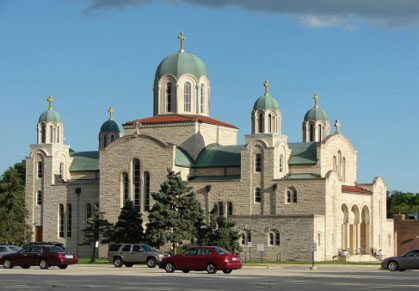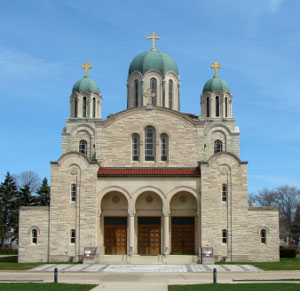60. St. Sava Serbian Orthodox Cathedral, 1956
3201 South 51st Street (at Euclid Avenue)
Architects: Camburas and Theodore (Chicago), in association with Lefebvre and Wiggins (Milwaukee)
St. Sava Serbian Orthodox Church was founded in 1912. At that time, there were approximately 2,500 people of Serbian birth or ancestry in Milwaukee. The first place of worship for the city’s Serbian Orthodox was on 3rd Street near National Avenue on the South Side. (That church is no longer extant.) Milwaukee’s Serbian population increased substantially following World War II, with the arrival in the United States of 400,000 immigrants from Central and Eastern Europe who had been displaced from their homes by the war. With its membership increasing, the church began to plan for the construction of a new and much larger place of worship.
The church acquired a 14-acre parcel bounded by 51st Street and Oklahoma Avenue, about four miles southwest of the previous church. This was a developing area that had only recently been annexed by the city. The first building constructed on the site was the American Serb Memorial Hall, which opened in 1950. To design its new cathedral, the church turned to the partnership of Camburas and Theodore, a Chicago firm with extensive experience in the design of Eastern Orthodox churches.
Peter Camburas (1892-1985) was born in Greece and came to the United States with his family in 1901, settling in Chicago. He studied architecture at the Ecole des Beaux-Arts in Paris following his service in the Army Corps of Engineers during World War I. Returning to the United States after the war and a year of study in Paris, he continued his education at Chicago’s Armour Institute (now the Illinois Institute of Technology). After working in the office of another Chicago architect for more than a decade, Camburas established his own office in 1937. His son-in-law, Theodore J. Theodore, studied civil engineering at Northwestern University and architecture at the University of Illinois. He joined Camburas in 1949 and became a partner in the firm in 1954. An expert on Byzantine architecture, Camburas was able to get commissions for more than twenty Greek Orthodox churches over the course of his career.
While Beth Israel Synagogue is a rather plain, rectangular building with a more ornamented Byzantine Revival front, St. Sava Cathedral exhibits a remarkable fidelity to the forms of ancient Byzantine churches. The cathedral features a prominent central dome, vaulted roofs, and smaller domes at each of the four corners. Camburas and Theodore not only looked to ancient Byzantine churches as models for the Milwaukee cathedral, but also focused on those Byzantine and later Byzantine Revival works located in what is now Serbia. The design was inspired in part by the church of the Gracanica Monastery in Kosovo, built in the early fourteenth century. The architects also drew upon the more recent churches of St. George in the town of Topola (completed in 1912) and St. Mark’s in Belgrade (completed in 1940).
Construction of St. Sava Cathedral began in 1956, with the first services held the following year and formal dedication in August of 1958. At the time of its completion, it was the largest Serbian Orthodox church in the United States. The interior walls, ceiling, and central dome are covered in glass mosaics imported from Italy. Installation of the mosaics began in 1969, progressing slowly over three and a half decades, with the work completed in 2004. St. Sava Cathedral is the city’s most distinctive example of revivalist architecture constructed in the post-World War II period, a time when all of the historical revival styles were passing out of common use.
Sources:
Dedication, St. Sava Serbian Orthodox Cathedral, Milwaukee, Wisconsin, August 30-31, 1958. St. Sava Serbian Orthodox Church, 1958.
Heinen, Tom. “Mosaics Come Together over Years of Fish Fries,” Milwaukee Journal-Sentinel, May 23, 2004, page B1, column 1.
Heise, Kenan. “Chicago Architect Peter Camburas” (obituary), Chicago Tribune, September 27, 1985, section 4, page11, column 1.
St. Sava Cathedral, Milwaukee, Wisconsin. St. Sava Serbian Orthodox Church, c. 1980.



